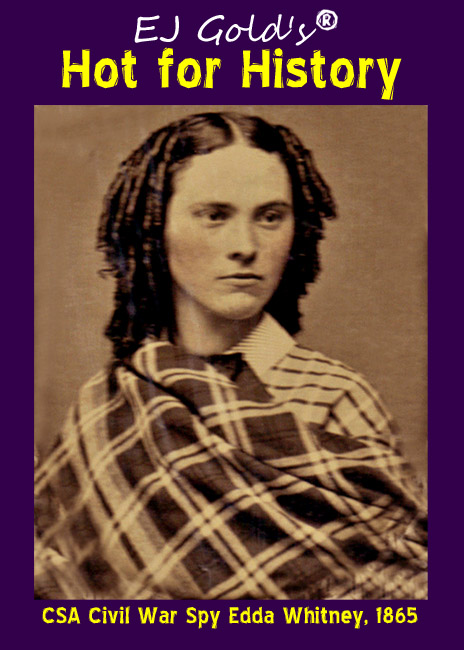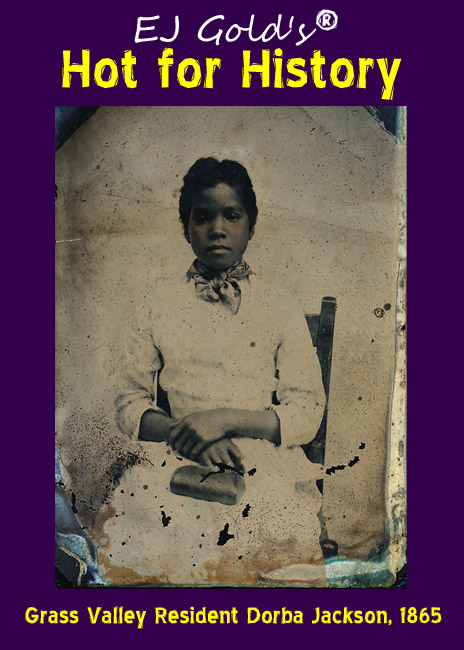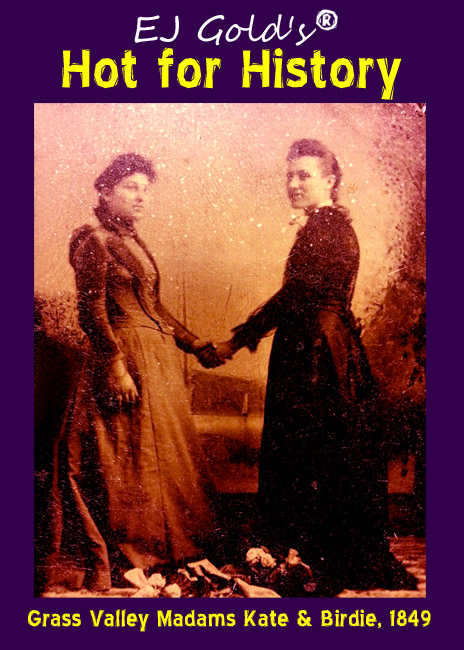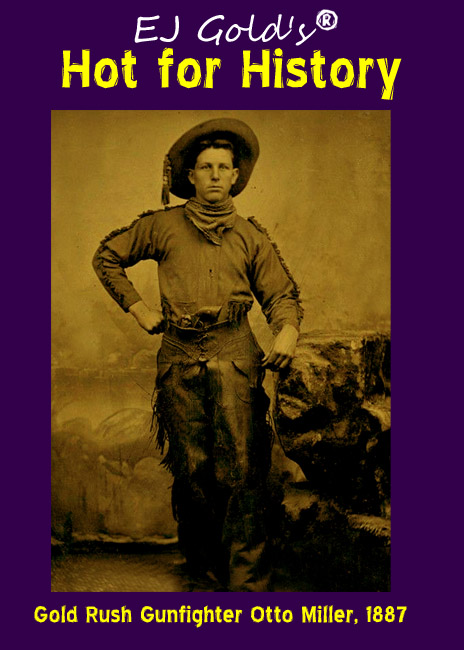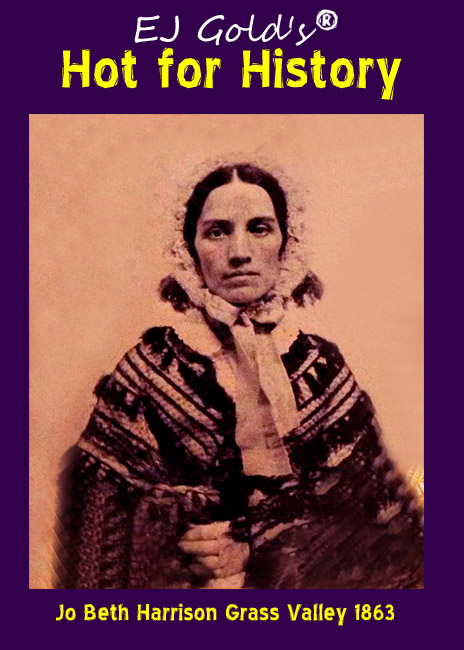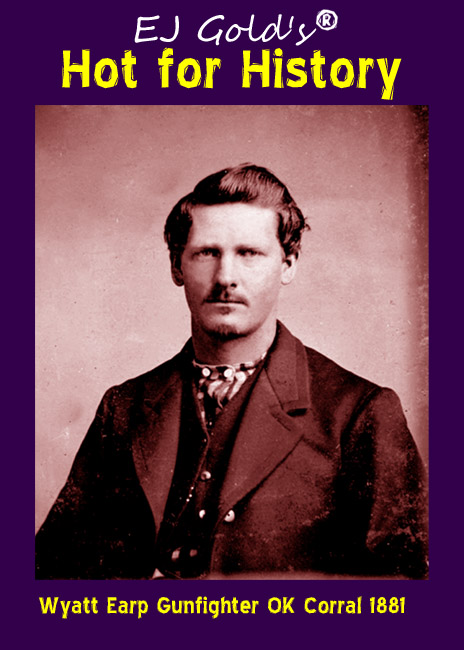It suddenly occurred to me the other day that trading cards are a very limited market…but the same images that produced those little trading cards could be used to produce larger items, such as greeting cards, notecards and postcards, all featuring real antique photos.
My notecard and postcard series are printed in full color, even though many of the photos are black & white, because the effect is that of seeing the original. Black-ink printing simply does not carry off this effect. In addition, most of the so-called “black & white” photographs are actually brown, sepiatone and some hand-colored with oil paints or watercolor tinting.
The notecards and postcards relate specifically to the Donner Party, Donner family, Nevada County residents, a few notorious Old West characters, and some very rare photos of world-famous Old West Lawmen.
The cards are created with images taken from actual Donner Family Heirloom vintage and antique photographs, called “Daguerreotypes”, “Ambrotypes”, “Tintypes”, “Colloid Plate”, “Silver Gelatin prints and other early forms of commercial and private photography.
The periods covered by my Donner Family Photo Collection are:
Georgian Period — 1714 – 1830 — Reign of the House of Hanover. All the Hanoverian kings were named “George”, from George I to George IV, with the exception of the short “Regency” Period, so named because George IV ruled during his father’s illness as Regent. The Georgian Period includes the short reign of William IV, who died in 1834.
This is the time of authors Henry Fielding, author of “Tom Jones”; Jane Austen, who authored “Pride and Prejudice”, and Mary Wollstonecraft Shelley, who wrote “Frankenstein”.
This was the time of the Romantic Poets, notably Percy Bysshe Shelley, Scot poet Robert Burns, Coleridge, Keats, Wordsworth (aptly named) and of course, the infamous Lord Byron. It was also the time of the Industrial Revolution and Mass Production. George III went crazy when the American Revolution broke out, and his son George IV took control.
This period also covers the abolition of slavery within the British Empire, and the founding of the original forms of Sunday School, Orphanages and Hospitals, none of which were around before that.
During this time, we had the French & Indian War of 1756 which lasted seven years, the American War of Independence, often incorrectly called the “American Revolution”. It was not a replacement of the English government, but a separation of a colony — Independence, not Revolution, see?
There was also the Irish Rebellion of 1798, and the unforgettable Napoleonic Wars which ended with the defeat of Napoleon by Wellington. Napoleon made one comeback and then was banished to exile on Elba Island.
During the Georgian Period, photography was re-invented and a succession of photographic image processing and development technologies were invented and perfected, meaning made safer and cheaper. About 1839 the first commercial photos were starting to appear, using primarily a bitumen process developed by Niepce and Daguerre, which sparked Calotypes made with silver nitrate and Collodian Processing, used by author Lewis Carroll to photograph neighborhood children.
At first, photography was a cheap and fast solution to family and pet portraits, and the demand was so great that even photography failed to meet it completely until Eastman developed the ultimate system for amateur photographers — “you shoot it, we print it”, which won the field for about half a century.
There are some recently discovered modern photographs dated to 1790, produced by an unknown lost process, but this is by no means beyond the pale — photography existed in very ancient times, back to the Sumerians who had the Camera Obscura. Pythagoras, Socrates, Plato, Aristotle and Euclid all describe a pinhole camera in enough detail to determine that a camera made in 433 B.C. was not very different from the Kodak “Brownie” camera manufactured for the masses back in 1901.
My first camera was a Kodak-Eastman Brownie; my second was the Ansco “Flash Clipper”, which sported a flashbulb that exploded into shattered glass, one out of three times.
I have several examples of the earliest commercially available color photos, called the “autochrome”, which first appeared sometime around 1907 or 1908. This was a difficult, complex and expensive technology, and its use was limited to a few incredibly wealthy landed gentry experimenters.
Victorian Period — June 20th, 1837 until January 22nd, 1901 — The Victorian Period starts and ends with Queen Victoria’s long and impressive reign. She was singularly responsible for about half the globe, as Empress of the British Empire, and she did much to expand her power and influence as possible, resulting in what we call the “modern world”.
It was during this period that we had The Civil War, the Indian Wars and the White Settlers. The Native Americans were being slaughtered to make room for immigrants coming by the millions from Europe, Asia and Asia Minor. 15 million people came from Ireland, Scotland and England in one single decade.
Luckily, the population was increasing and the rate of birth doubled and redoubled as the Industrial Revolution made it economically imperative to marry and have progeny, and medical practices improved to reduce infant mortality.
During this period, the grim and grisly practice of “post-mortem” photography emerged; dead bodies were hauled into the mortuaries for “last-0photo opportunities” — dogs, cats, infants, were photographed dead, dead, deadski. Some studios had that sweet carnation mortuary odor as a result.
I try not to publish postmortem photos unless they have historical relevance, and most of them don’t. Many of my photos are the only existing photos of some important historical figures. I of course have photos of all the Donner family, along with as-yet unpublished letters, diaries and other vital documents detailing this important part of local history.
Although many of the Donners landed in Yakima, Washington and Santa Ana, California, it is also true that several members of the Donner family, including my own branch of the line, settled in Nevada County, Northern California, at or near where the Donner Party Tragedy occurred.
Several members of the family still live in Truckee, and near Donner Lake, and we live in Grass Valley, California, the home of many Donner family folks. The Donner Party event is one of only three arguably “most important” events related to California, meaning that almost everyone you meet will know of at least two of them.
1. The Great San Francisco Earthquake & Fire of 1906.
2. The ’49er Gold Rush.
3. The Donner Party Tragedy.
My photo collection spans the period from Georgian all the way through Victorian, and well into the Edwardian Period, from 1901 to 1918, to include World War I. The Titanic went down in 1912, to help you find its place on the timeline.
Photos I will be releasing first will be related to our local communities of Grass Valley & Nevada City and the surrounding area to include Truckee, parts of Western Nevada and most of the area of Northern California, and then we’ll see about expanding that later.
I have also assembled a sub-collection of vintage “risque” photos from my grandmother Celia’s collection. She was a well-known “flapper” and friend of Sophie Tucker, and had been an RN (Registered Nurse) during two world wars and the Korean Conflict. When Nana Celia retired from nursing, she began a new career as a cabaret style singer, encouraged by her show business friends, and achieved some small fame in the Yiddish Theater. She continued to work as an unpaid nurse for many newly-arrived Puerto-Rican families along 75th street, between Broadway and West End Avenue, for many years until her death in 1959, which had the odd and wonderful result of a large crowd of unrelated Puerto-Ricans gathered at her funeral in the tiny Jewish cemetery on Long Island.
It is her photos that you will see in the “vintage hairstyles” and “vintage fashions” post and note cards I’ve produced for your pleasure and edification. None of the nudes are in any way lascivious or obscene. All the photos I release out of my collection are of the very highest aesthetic.
I have also developed a line of vintage photo note and greeting cards that feature actual artifacts from the folks pictured, including textiles, paper and small, thin objects that date from that time.
In addition, I’m now starting to produce a line of ACTUAL vintage cards, that include real cards from the Georgian, Victorian and Edwardian Periods! These are expensive and by their nature, one-of-a-kind, but you’ve never seen anything like them!
With my large collection of early photos, I can create an entire line of cards for YOU!
Simply tell me where you live or what part of history (from 1800 to 1920) you want to cover, and which events are important to you. I will search my photo library, which includes many glass plate photos, so it takes some time, then using non-actinic light, I will copy the image into my new Canon digital photo system, send it to PhotoShop and there massage it into new, sparkling beauty, whilst at the same time creating a “new” image which can be, and is most assuredly, fully copyrighted and trademarked.
You can buy the cards from me or lease the images and create your very own cards, if you like; I put my name on things only for marketing purposes — I have no interest in the approbation of ape-descendents. You can market these images under your own business identity and branding!
If you own a business, there’s no better way to say “hello” and to remind a customer that you’re there, than a greeting card, especially an interesting one that relates to your customer’s hometown or special interest…speaking of “special interest”…
I have a section of photographs related strictly to science fiction, fantasy and horror, and another related to Hollywood and the New York Stage. Not sure yet what part they’ll play, if any, in the notecard area, but we’ll see as things develop.
Several areas not yet developed, but sitting there in the midst of my photo collection, just waiting to be put into service, are the following subjects:
World War I — The French Campaign.
World War II — Africa, Europe, South Pacific.
Women of the West — Early pioneer women and notorious ladies of the Golden West, including a previously unseen and unpublished photo of Belle Starr, another of Annie Oakley (this one does include a postmortem, her sister, the cause of the photo session) and Fatima Jackson, the famous Grass Valley madam of the ’49er Gold Rush days.
Outlaws and Lawmen — Post-Civil-War & Indian Wars photos of the gunslingers of the Old West. I have hundreds of rare photos, including unpublished photos of many early lawmen, notably the never-once-wounded gunfighter Wyatt Earp, who worked as a technical adviser in the film industry; he lived at 4004 W 17th Street, in Hollywood, California, on the corner of 17th and Norton — until his death on January 13, 1929 at the age of 80. He was survived by his common-law wife of 46 years, Josephine “Josie” — he called her “Sadie”, who was so overcome by his death, she was unable to attend the ceremony. She was Jewish, and his remains were cremated and buried at Hills of Eternity, a Jewish cemetery located in Colma, California.
When he died, his fame was more about his decision ending the Fitzsimmons-Sharkey fight than the lone survivor of the not-yet-famous Gunfight at the OK Corral. His fame was sparked by a posthumous fictional biography written by an author after talking with Josie for a few hours; the book is now known to be totally from the imagination of the author, but at the time, 1929, he became a legend and a hero forever, spawning a plethora of books, movies and tv shows about the legendary Wyatt Earp of Tombstone, Arizona.
Actually, he was a very successful gold and copper miner, whose personal wealth exceeded $3 million in today’s money, and during the last years of his life, filed over 100 successful gold mining claims in California’s San Bernardino Mountains near Crestline, California, and some very high-pay rich claims in the Mojave Desert, which he’d been working for years. His first successful claims were in Idaho many years earlier.
Well, hero or not, he was and is one of the great legends of the Golden West, and I have photos of him given by Josie to my Nana Celia sometime between 1918 and 1929, perhaps in several packets, as indicated by letters between them.
I also have a very extensive collection of Spencerian Penmanship System actual pen and ink handwriting samples dating from 1888 to 1919. These are genuine antiques and are attached to cards. They are rare, expensive and suitable for framing. Merely remove the card (they are attached with removable non-damaging museum grade cement tape, which will not damage the original artwork in any way) and FRAME IT in any of 100,000 readymade “photo” frames, some of which resemble antique Victorian frames, etc.
You can match the frame style to the period of the photo or artifact.
How about a postcard or greeting card that featured actual ancient fabric or textile samples?
What would you give for a line of greeting cards that sported real, signed original artwork, such as pastel, crayon, pen-and-ink, charcoal, watercolor, oil, acrylic, encaustic wax, embossed metal, pencil drawing, ribbon art, yarn weavings, or totally multi-media?
What about a set of greeting, note and post cards featuring vintage photos, mostly Victorian and Edwardian, of horses, cats, dogs, babies (not postmortems), birds, trains, early automobiles, city streets, circus and theater, cowboys, Wild West showgirls and more, virtually any subject you can name, right down to a visit to Hong Kong in 1934, a photographic tour of Manila in 1945 and a series of photos related to Abe Lincoln, including several pre-beard Brady photos, the originals of which are NOT for sale.
The eventual fate of the collection is to land in a museum, but the average museum is a one-way path to oblivion in the form of eternal storage in the company of an identity ticket — one of many boxed-up copies of the Ark of the Covenant in a sea of arks of the covenant.
I’m describing the average graduate library or public museum. There are exceptions, but they are few and far-between. It’s not due to lack of interest in maintaining the collections and making them available to the public — it’s all a matter of money.
Typically, a museum displays about 1/10,000th of its collection at any one time. This is NOT an exaggeration, and many, such as the Brooklyn Museum and the Museum of Arts & Crafts in NYC show about one-millionth of their total collections. Exhibition space is limited, and the time, attention and expertise of graduate students, who typically will be instructed to set up the exhibits, is even more limited.
Consequently, the best approach to public access is, I believe, to publish the collections as greeting cards with detachable graphics, suitable for framing, and then, when all have been graphically preserved, they will be on exhibit at MAMA and other museums I’ve selected to receive them.
Well, that’s it, unless you want me to include mention of an unpublished photo of General Tom Thumb, who worked for Phineas T. Barnum as the World’s Smallest Giant, and the photos given to me by my Aunt Sophie, about whom I tell many funny stories — she was a funny lady, who was involved in the legit Yiddish theatre and in early Hollywood films, along with my Uncles Al and Lou Semels, who owned six Hollywood studios in all, ending up as the #1 “Movie Trailer” company of the 1940s.
Uncle Al can be seen in a number of MGM films — he’s the heavily mustachioed organ-grinder. He looked totally Italian, but was a Polish-American. He worked for Goldwyn for nothing; he was terribly rich, especially after Goldwyn had bought a total of five out of six studios from him, studios that he had built and made into Hollywood success stories.
Uncle Al lived in sin, with Aunt Kittie. They were common-law and very happily unmarried; their relationship lasted their entire lifetimes. They passed within a month of each other; he went first.
My Aunt Sophie and her friends are the subjects of Bathing Beauties of the Victorian Age…I forgot to mention it, but luckily she’s still in contact (L343) and asked me to mention it. What’s the good of paying for a bunch of cabinet photos if nobody sees them? I agree with her, and will be offering her wonderful antique glamor photos on her behalf, thus producing a double benefit — your interest and edification, and the realization of her Ultimate Life-Goal, Posthumous Wealth & Fame, a worthy aspiration in anyone’s book.
What I didn’t mention, and perhaps should mention here, is my idea of creating a set of Coinology Greeting Cards. How they’re made and how they get their message across is unique, I think, in the greeting card industry.
Dang, gotta blast off and finish the sample cards in time for this morning’s ICW at 6:30. Just had another idea, for a perfumed card from our Alchemical Gold Perfumery. What an idea that could develop into!!!
Gosh, do you think anyone would appreciate a greeting card that featured a …. gee, whillikers, I wish I had time to mention all the stuff that … gosh, gotta go now.
See You At The Top!!!
gorby


